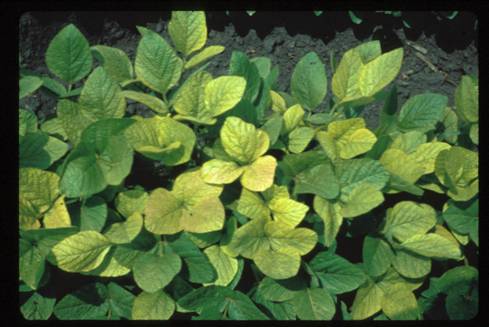Iron (Fe++)
Functions
Iron is essential for many plant functions. Some of them are:
- Chlorophyll development and function.
- It plays a role in energy transfer within the plant.
- It is a constituent of certain enzymes and proteins.
- Iron functions in plant respiration, and plant metabolism.
- It is involved in nitrogen fixation
Factors Affecting Availability
- Soil pH: High soil pH reduces Fe availability while acid soils increase Fe availability. The high pH effect is increased in waterlogged, compacted, or other poorly aerated soils. One factor in this effect is the presence of high carbonates in the soil, which also plays a role in waterlogged soils and in the root rhizosphere reaction to certain other nutrients and fertilizer sources.
- Low Organic Matter: In addition to being a source of Fe, O.M. compounds are able to form Fe complexes that improve availability.
- Saturated, Compacted, or Other Poorly Aerated Soils: In acid soils, this condition can increase Fe availability (to the point of toxicity).
- High Soil P: Excessive amounts of soluble P, or high rates of P fertilizer, have been demonstrated to inhibit Fe uptake in many crops.
- Form Of N Applied: Increased NO3 -N uptake can reduce Fe uptake by causing an anion-cation imbalance in the plant.
- Fe:Zn Balance: Zn deficiency has been shown to increase the Fe uptake of many crops, sometimes to the point of toxicity. Conversely, high Zn availability reduces Fe uptake.
- Fe:Mn Balance: It is well documented that these two elements are antagonistic, and one will inhibit the uptake of the other.
- K:Fe Balance: K appears to play a very specific, but poorly understood role in the utilization of Fe. Some research indicates that low K availability can result in increased Fe uptake.
- Fe:Mo Balance: High levels of available Mo can reduce the uptake of Fe by causing the precipitation of iron molybdate on the root surfaces. This is especially important in alkaline soils where the high pH reduces the availability of Fe while increasing that of Mo.
- HCO3- : Iron deficiency can be induced by the presence of the bicarbonate ion in the soil (saline and alkali conditions).
High Response Crops
While this is an essential element for all plants, these crops have been found to be especially responsive: alfalfa, asparagus, barley, beans (white), beets, broccoli, brussel sprouts, cabbage, cauliflower, celery, citrus, grass, oats, peanuts, rye, rice, soybean, sorghum, spinach, strawberry, sudangrass, tomato, and turf.
Some acid-loving crops, such as blueberries, cranberries, some conifers, and some ornamentals such as azaleas and blue hibiscus may exhibit Fe deficiency induced by excessive Mn uptake.
Deficiency Symptoms
Interveinal chlorosis of young leaves. Severe deficiencies may progressively affect the entire plant turning the leaves from yellow to bleached-white.
Toxicity Symptoms
Iron toxicity is primarily pH related and occurs where the soil pH has dropped sufficiently to create an excess of available Iron. As with some other nutrients, the visible symptoms of Fe toxicity are likely to be a deficiency of another nutrient. Fe toxicity can also occur when Zinc is deficient, or the soil is in a “reduced” condition caused by very wet or flooded conditions. Excess Fe can result in Dark green foliage, stunted growth of tops and roots, dark brown to purple leaves on some plants (e.g. bronzing disease of rice).
Using Iron in a Fertility Program
Luckily, most agricultural soils provide an abundant supply of Fe to plants, because iron can be more difficult to use in a fertility program than other nutrients. Most soil application methods are often not very effective, while the needed multiple foliar applications are often too expensive, or labor intensive.
Iron presents some difficulties for plant analysis also because
1. it is often a contaminate on samples that have any dust on them
2. Fe can exist in a leaf in a non-functional form
3. a crop may respond to foliar Fe due to a low Fe:Mn ratio in the tissue, even when Fe is adequate by “critical level” standards.
| Recommended Rates | ||
|---|---|---|
| Method | Rate | |
| Broadcast | Not Recommended | |
| In-rowa | Follow label rates | |
| Foliarb | 1.0 to 2.0 lb./A | |
aCertain proprietary chelated Fe products appear to be effective when applied in the row, otherwise only foliar Fe is recommended.
bFoliar sprays should include a wetting agent. However, be sure to test the mixture for precipitation before using.
Both chelates and citrate acidified (reduced) sulfates are effective for foliar applications. Cost is the primary factor. Avoid the use of sulfates, or solutions which have a rusty color. This often indicates that the Fe has oxidized and the spray material may not be fully available to the crop.
Be concerned if visible symptoms are evident, since this indicates serious reductions in growth has already occurred. Annual corrective applications to solve Iron deficiencies can be both expensive and difficult. It is best to try and understand, then control the interaction which caused the Iron problem. Often a simple reduction in the application rate of Phosphorus or proper liming more easily solves the problem. Where an excessively high soil pH is the cause, be aware that acidifying the soil is very expensive, and not normally cost-effective for agronomic crops.
| Some common fertilizer products containing Iron | ||
|---|---|---|
| Product | Chemical Formula | Typical Iron Content |
| Ferrous Sulfate | FeSO4 • 7H2O | 20% |
| Ferrous Ammonium Sulfate | (NH4) 2SO4 • FeSO4 • 6H2O | 14% |
| Iron DPTA Chelate | FeDPTA | 10% |
| Iron HEDTA Chelate | FeHEDTA | 5-12% |
